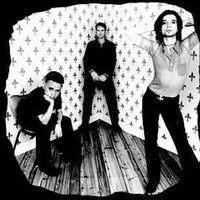Like all good art, the lyrics to Depeche Mode songs such as "Master and Servant" and "Strangelove" leave room for interpretation. In the small minds of young homophobes, most interpretations erred on the side of man-on-man dungeon sex sessions filled with drugs, oils and punishment. In "Strangelove," lead vocalist Dave Gahan sang: "strange highs and strange lows. Strangelove, that's how our love goes. …Pain. Will you return it?" In "Master and Servant" he sang about a new game that's a lot like life, a "play between the sheets. With you on top and me underneath, forget all about equality." The latter song only fed rumors that the band was gay by featuring a cracking whip sound as part of the beat.
DM played these songs on Casio keyboards, not Gibson Flying-Vs, and used a drum track, not a live, stick-wielding drummer. They were essentially pasty computer geeks programming music instead of video games for a living, nerds who'd ended up on the concert stage rather than behind it working the lights. And, like me, they had no reputation as heartbreakers to defend them. Where I went to school, this presented a problem.
1989: Better known as the year of the Exxon Valdez spill, the year the Iron Curtain first cracked, it was also the year I became a huge Depeche Mode fan in eighth grade. I mail-ordered concert tees from tours I was too young to attend. I coated my bedroom with posters. Rare European vinyl bootlegs sat stacked beside my record player. I even painted the letters "DM" on the wall beside my bed, later adding the rose from the cover of Violator when that album came out in 1990.
Violator – wasn't that just a reference to a double-crossing woman?
Judging from the huge crowds at their 1988 US Music for the Masses tour, the gay rap didn't much diminish the band's popular appeal, but it did threaten mine. I entered an all-boys Catholic high school in 1989, at the height of my fandom. No matter the city, most all-boys' schools get the same reputation: they're where students are trained to become America's future choir teachers, bath house patrons and Crate & Barrel franchise owners. As Phoenix's only all-boys high school, we at Brophy College Preparatory earned the same reputation.
As ludicrous as the "gay prep school" rep was, it didn't change the facts: wearing a DM shirt at Brophy was as socially damning a move as holding your buddy's hand. Single-sex high school fosters a climate of fear and mutual suspicion. To be labeled gay in this environment is to potentially be ostracized from the entire student body: some 1,029 students, around 243 in my class. With no girls to flirt with or ask out, how was a Brophy boy going to step outside the shadow of his favorite leather-bearing, lipstick-wearing band and establish his heterosexuality? Easy. Take his fandom into the closet and deny, deny, deny.
Wearing a DM shirt at Brophy was as socially damning a move as holding your buddy's hand.
Brophy dress code required that students wear collared shirts, so I concealed my DM tees beneath regulation button-ups. I invited only my closest friends into my embarrassing shrine of a bedroom. I spoke of the bootleg collection to local record store clerks as a cigar connoisseur might speak of his pre-embargo Cubans. Recollections of the Phoenix Violator tour concert were strictly reserved for my female friends. I liked girls, thought about them constantly, imagined one day I'd fall in love with one, if only any might let me take them to a movie. In lieu of an impressive romantic résumé to flaunt, I concealed my fandom to preserve my image as a standard-issue 14-year-old, but that tact wouldn't alter people's perception of DM.
There might not have been definitive proof that Depeche Mode was Depeche 'Mo, but there was no evidence to the contrary either. And if the inference people drew from the circumstantial evidence was a stretch, it was also, admittedly, an understandable one. Watch any video. Check out old interviews. Band members Martin, Dave, Alan and Andrew were slight, articulate, British men. DM wore whole cow herds' worth of leather and used to sport bondage gear straight out of a West Village S&M shop. When they debuted in 1980, they looked as if they'd just returned from Gay Pride Week in Washington, D.C.: leather pants, leather shirts, leather biker captain caps, aviator glasses. Chains draped across nearly every article; everything was buckles and straps. They made Rob Halford of Judas Priest look as huggable as a beagle, and that was just their first album.
After the early-'80s "leather daddy" fad diminished, DM developed a sharper, more chic urban image: leather jackets with zip-up wrists, Army-Navy flak jackets, thick motorcycle boots, black turtle necks with a zipper up the front. Everything from this period seemed webbed with zippers. DM in '89 were the clean urban males, which in many peoples' minds meant gay urban males, metrosexual long before the term. Ours is a culture that equates debauchery with manliness and godliness, and these guys had no Zeppelin-grade drunken rock star antics to precede them and left no trail of sullied groupies behind them. Somehow in my teenage brain, not wearing the shirts wasn't an option, so I defended the band and myself as best I could.
When the Mode subject came up outside my controlled environments, I offered a prefabricated answer for every charge then quickly changed the subject. If a student in math class said the members seemed effeminate, I'd say, "Of course they do. They're British."
If an acquaintance at a party questioned the whip sound, I'd say, "‘Master and Servant' is a political song. England has a long history of labor strife."
What about Martin's love of gossamer shirts? "Maybe the breeze cools him during concerts."
His shirtless period before that? "If you had a stadium full of woman lusting after you, wouldn't you remove your clothing?"
The bondage straps? "Plenty of heteros like to get smacked around."
As for the county of Essex where the band formed, I could only point to the absence of the word "man" in the name. But to the hasty judge and unreasonable jury, explanations weren't proof. Hard evidence was required to overturn the verdict. Like with my friend Jody's brother Cody.
Cody knew of my fandom because Jody, who I'd trusted with my secret, told him. Cody was raised in western Colorado. He drank Coors, chewed Copenhagen, always wore jeans. One day while discussing his efforts to get on the rodeo circuit, Cody brought up DM. "You show me a picture of that fruity one with the white hair," he said, "what's his name?"
Jody called out from the other room, "Martin Gore."
"Yeah," Cody said, "a picture of that faggot Marteeen Whore fuckin' some groupie chick, and I'll shut my yap." Even if such a picture existed, I knew I couldn't get it.
This was a world before the internet. You couldn't just type "Martin Gore + lady's man" and find articles quoting him saying, "My wife inspired that song." What info fans had was largely generated from other fans. This info arrived as hand-me-down gossip diluted by multiple generations of telling; direct info came from MTV videos and the low-quality TV interviews rabid fans in German bootleg circles mailed you copies of on VHS. Even the fan community debated Martin's sexuality. On a moral, personal and cosmic level, none of this mattered.
Aside from the offensive phrasing, Cody's contention mirrored most naysayers' suspicions: the issue wasn't Dave, Alan or Andrew so much as Martin. Everyone's eyes went straight to him. He was the one who continued to stripe his bare chest with bondage straps after other members went to flak jackets. He was the one who wrote the "Master and Servant" lyrics, the one showing his nipples through shimmering gossamer in concert, the one whose gentle manner resembled an effeminate whisper in interviews and who wore rouge and lip gloss as casually as Cher. After the biker fad, Martin incorporated elements of those early London Underground days into his evolving look. During the Black Celebration period, he sometimes appeared bare-chested in an ankle-length dress, open leather jacket and broad brimmed black hat, a look that made you wonder what Culture Club would've sounded like had Boy George gotten into Alistair Crowley. The number of chains Martin draped around his neck also suggested a Mister T. fetish. He even wore straps zigzagging his crotch, synched tight in an X, as if somehow his genitals weren't fixed securely enough to hang on their own. Had I surrounded myself with other aspiring bull-riders or been raised in a rural home, I might have taken this for the Official Homosexual Uniform, especially when I first saw the cover of Catching Up with Depeche Mode.

Catching Up with Depeche Mode (1985).
In this black and white photo, Dave, Alan and Andrew surround a shirtless Martin. With the image's natural color removed, each man's innate pastiness reaches a blinding, nuclear crescendo, yet the central details remain clear: Martin's top, a delicate, lingerie-type number made of black lace, hangs low, revealing his right, curved pectoral. With its crescent of shadow it resembles a woman's breast. A single bra-like strap drapes across his bicep, as if he'd just sat up from a nap and forgotten to straighten his clothes. The blokes crowd around him, looking, as a friend once described, "like puppies awaiting their turn at mamma's nipple." Alan even rested his chin on Martin's bare shoulder for that shoot. Part of me loved that they didn't give a damn what people thought, but looking at that photo, what could I have said to un-convince anyone?
I did my best. "They're artists," I argued. "Nail polish, eye liner, it's all shtick and marketing. Motley Crüe wears tights and rouge and nobody calls them queens." People pointed out that the Crüe supposedly screwed half of LA's female population and played beside flaming pentagrams and flash pots.
I tried other angles: "The lace and leather are standard rock and roll props." This made people laugh. "Rock and roll?" people said. Three of the four band members stood behind synthesizers for most of their concerts. Just stood there, barely swaying at the knees and hips. Cody told me that, "Real rock stars don't bang their heads in the heat of a synthesizer solo," then he snickered at the words "bang" and "head." Even my closest Brophy friends, refined students who used words like algorithm and taxonomy, resisted the rock prop hypothesis. "Casio players," they argued, "aren't in the same musical genus as Hendrix, The Clash, The Ramones." Even though Martin had recently started playing more guitar with the Violator album, no one was going to give him credit for it, at least not enough to overcome the reputation. I was blowing smoke up peoples' asses. Even I could see that.
***
Before Brophy, I attended a co-ed middle school, where I had high hopes for a certain girl: Tanya. She and her small, tight-knit group of female friends were huge DM fans; no surprise it was she who inadvertently introduced me to the band. As eighth-graders, these girls sported their black DM concert tees, chatted constantly about the famous Rose Bowl concert captured on the 101 album and longed for the band's next Arizona performance. They also refused to date any of my middle school buddies because, they joked, they were already married to their self-appointed DM "husbands": one girl loved Martin, one loved Alan, another Dave. Curious what it was about these Brits that had her so enamored, I bought Music for the Masses.
While spinning the LP alone in my room, I discovered a partial explanation: the music was good. Better than good, it was addictive. The haunted melodies, inventive percussions, moody ambiance set by deep sonic layers – I wanted to soak forever in those sounds. They struck me drunk, a sensation as mysterious and domineering at age 13 as my crush on Tanya. Within a couple months I had joined the girls' ranks of obsessed fandom. I bought every album, working my way backward through the DM catalogue, graduating to bootlegs when I ran out of studio recordings, then spent my weekends scouring record store bins for over-priced imports featuring multiple dance-remixes of a single song with names like the "Renegade Soundwave Afghan Surgery Mix." While the music became my true master, I secretly hoped Tanya's and my shared interest would forge a friendship that might lead to friendly phone calls, a date, maybe some kissing to "Strangelove." Instead of stripping each other of our DM shirts underneath my postered walls, we graduated from middle school, having mostly talked about the band. She never gave me her phone number.
Why I bothered wearing DM shirts only to hide them mystified me. Was it a taunt? A call for someone to see my shirt and call me a fag, so I could practice the art of verbal self-defense? Maybe I was hoping for a confrontation, that circumstance would force me to take the stand my will was too weak to take: "I am a DM fan," I would then have to proclaim. Maybe I was warming up for the inevitable full-disclosure. Disguise was a cultural halfway house: first you hide the shirt under another shirt; next you unbutton the other shirt to reveal the undershirt; soon you're wearing just the shirt, no protection, and defending your tastes like an adult – like a man – when people comment on them. Real men take hits when life throws punches, but I was a baby, hiding. No, I was a flower, a stunted bud too young to even unfurl his little precious petals. Aah, a flower.
Clearly I was doing something wrong.
In 1990 it seemed half the guys my age were banging their heads to Motley Crüe's "Dr. Feelgood" and Aerosmith's "Love in an Elevator." For some reason, many in the upper echelons of Brophy's ranks – the football players, the kids who drove Ford Broncos because the school's mascot was a bronco – worshipped Van Halen. Hard-rocking, hard-living, best played at high volume, Halen seemed to power my classmates' budding masculinity like sunlight to a sapling pine. Eddie Van Halen churned out blazing guitar solos shirtless and scored a hot actress wife. Michael Anthony played a bass shaped like a Jack Daniels bottle. David Lee Roth sang about how bad he had it ("so bad") for a foxy teacher. In addition to the licks and high head-banging quotient, "Jamie's Cryin'," "Ain't Talkin' 'bout Love" and numerous other songs oozed sexuality, offering such tawdry, sing-along lines as "He wanted her tonight, and it was now or never" and, "My love is rotten to the core."
Even though the bulge in Roth's tights loomed a bit large for my taste, guys at school were picking up what Halen was laying down. The message, in adolescent terms: machismo is in your face, get used to it. So they passed tins of Copenhagen in class, left spent brown wads in the drinking fountains. Others, like class alpha male Darren, fanned their farts to nearby students. I once watched Darren unbend a paper clip in history and use its length to pick his nose. There, in the front row of a U-shaped seating arrangement, he studied the contraption and the excavated junk on its tip, proud of his ingenuity. He stared at his tool as if he'd invented the nasal equivalent of one of those Reach toothbrushes with the curved necks. Why did I care what these people thought?
Looking back on some of rock's most iconic stories, albums and images, it's clear that, like a shrimp, I had been absorbing the toxins that pollute America's cultural waters: the idea that debauchery and sexual excess were the same as manliness.
I had been absorbing the toxins that pollute America's cultural waters: the idea that debauchery and sexual excess were the same as manliness.
Neal Preston's 1975 photo of Led Zeppelin guitarist Jimmy Page swilling from a bottle of Jack Daniels backstage in Indianapolis captures the proud hedonism many non-musicians envy about the rock and roll lifestyle. Then there was the time Zeppelin road manager Richard Cole stuck the nose of a red snapper inside a redheaded fan's vagina in a hotel room, confirming the popular fantasy of the touring musician's nightly sexual indulgences.
Motley Crüe were as famous for their backstage womanizing and drug consumption as for their music, and the lyrics on their 1987 album Girls, Girls, Girls celebrate the band's passions and experiences: whiskey, sex, motorcycles, strip clubs, drugs and general rowdiness. Girls is one of the Crüe's two most popular albums, its namesake song one of metal's celebrated anthems. As if to legitimize such recklessness, their 1989 song "Kickstart My Heart" – inspired by the two adrenalin shots that revived bassist Nikki Sixx after his near-fatal heroin overdose – was nominated for a Grammy.
And Guns 'N Roses' lead guitarist Slash bears all the habits and accoutrements of what has to come to embody the so-called true rock and roller: leather pants, long hair, dark sunglasses, soloing on stage with a lit cigarette in his mouth. The name of GNR's first and best album, Appetite for Destruction, so precisely sums up rock culture's macho value system it could have been titled Appetite for Self-Destruction.
The idea that these guys are supposedly "real men" is laughable to me now. But as a kid, it made me check my pants to clarify what I was.
***
Since graduating high school in 1993, I have lived on both coasts, shared apartments with a few past girlfriends, seen some of my favorite musicians perform – from saxophone colossus Sonny Rollins to bluesman RL Burnside – and remain deep into jazz, rock and surf instrumental music. Yet I never unveiled my love for DM. I just outgrew it.
By the time sophomore year of high school started, I was burnt on synth. Three of Violator's four singles had been playing incessantly on MTV and radio all summer, and when the last single, "World in My Eyes," started rotation in September, I was suffering the musical equivalent of a vitamin deficiency. I needed guitars, drums, distortion pedals and screaming. I missed the punk urgency of the guitar-bands like The Cramps I'd listened to before the electronica tsunami swallowed me. I removed the Depeche posters from my walls and tucked the t-shirts into a drawer. I sold my bootleg records – which had become a novelty in the age of CDs – and bought new CDs with the money they generated: Bad Brains, Meat Puppets, Mudhoney, Jane's Addiction. It took a few coats of paint to cover my wall-art, but eventually, those disappeared too.
A few years ago I found a bootleg CD of DM's 1984 Hamburg concert at a used music store. It's a concert I once owned on vinyl and liked better than their period studio recordings. Now it's on my iPod, sandwiched between Dead Moon and Dex Romweber, and the concert's version of the song "Photographic" still strikes me as one of the most stirring live songs I've ever heard.
First comes the crowd noise. Then, a faint electron twittering etches itself across the roar. Then the base drum. It strikes hard, beating in sync with my own roused heart before Dave sings: "A white house, a white room, the program of today." I still don't know what he's signing about, but I sing along anyway. Listening now, I hear what I failed to during my youth: It's not the lyrics that move me so much as the harmonies, the parts where Martin lays his high voice atop Dave's deep one. "And looking to the day," they sing, "I mesmerize the light." The unusual keys, the combination of opposites, two men signing together – it's a haunting union. Despite their driving rhythms and complex orchestrations, what remains the band's most enduring draw for me are the harmonies. Two men singing together – it doesn't sound very macho, but neither do the life stories of some of rock's biggest badasses.
After drinking forty measures of vodka during a day of band practice, Led Zeppelin drummer John Bonham died at age 32 from pulmonary edema: fatal water-logging of the lungs caused by inhaling his own vomit. Jimi Hendrix died alone, at age 27, in his girlfriend's London flat; he asphyxiated on his own vomit, composed mainly of red wine, after possibly ingesting too many sleeping pills. Guns 'N Roses' old drummer Steven Adler still struggles with drug addiction 18 years after the band fired him for substance abuse. You can watch the tragic drama on VH1's TV show Celebrity Rehab Presents Sober House. Check out his lip. It sags thanks to a potent speedball injection that caused a stroke in '96. Before those adrenalin shots revived him, Motley Crüe's Nikki Sixx was medically dead for two minutes after that heroin overdose. And Crüe lead singer Vince Neil killed his friend and passenger, Hanoi Rocks drummer Nicholas "Razzle" Dingley, in a head-on collision in 1984. They were returning from the liquor store.
Recently, I found video footage of the Hamburg concert on Youtube. While watching other old videos there, I discovered something I'd missed back in high school: Martin kisses a woman in the "Policy of Truth" video. All the band members kiss women in that video. The "Master and Servant" video features images of politicians and laborers, alternating with images of Martin wearing lipstick and, at one point, a large-haired woman lip-syncing, wearing lipstick too. Naturally, this led me to Wikipedia, where I discovered the answer to that 18-year-old question. Martin Gore, it said, "is now divorced from his wife of twelve years, lingerie designer and model Suzanne Boisvert-Gore. He has three children." Biological children, with a lingerie model.
In reviewing the images marking that time, it's clear that, besides my dad and my granddad, Martin Gore was the most manly man in my life freshman year. People called him and the band puffs for wearing dresses and nail polish, but that's what made Martin tough. Crotch straps, chains – if he liked it, he wore it.
Back in high school, I wanted to believe my attraction to Martin was strictly artistic: it was about the music, not the man. Wasn't one side effect of worshiping art the tendency to mimic its creator? Same way you buy concert t-shirts and overpriced import CDs to remain in perpetual contact with the music? But to say I loved his music and not his mind now seems overly simplistic. The line between fandom and affection, admiration and attraction, blurs too much for such clean, easy summaries. If not his appearance, then what was I drawn to? The person. The mystique of creativity, the magnetic charisma of the inspired, soft-spoken, mastermind. To birth transcendent music seemed a power of the gods.
This is what fascinates me now: the way such exquisite turbulence can churn inside a seemingly meek individual. And that one year of high school, as smothering as it felt when I lived it, liberated me from the confines of caveman pop culture. Martin showed me that personality matters. I know this is the stuff guys tell women to sound charming and deep in order to sleep with them, but unlike a t-shirt, you can't hide this fact: personality is everything. Without it, beauty fades, drugs disappoint, the hottest sex still leaves us wanting for love.
I'm not saying anything new to the world here. It's only new to me.
Aaron Gilbreath is an essayist and journalist. He has written essays for The New York Times, Paris Review, Tin House, Kenyon Review, Black Warrior Review, and Brick, and articles for the Oxford American, The Awl and Yeti. This essay first appeared in Fugue and was reprinted with permission.
In a new project overseen by contributing editor Kiese Laymon, Gawker is running a personal essay every weekend. Please send suggestions tosaturdays@gawker.com.





